Understanding Different Types of Companies and Their Operations
VerifiedAdded on 2023/01/06
|11
|2640
|99
AI Summary
This report provides an in-depth understanding of different types of companies and how they operate. It explores the characteristics of micro, small, medium, and large businesses, along with their legal structures. The report also discusses the impact of external factors such as politics, economy, society, technology, and environment on businesses. Additionally, it provides insights into organisational structures and how the business environment affects productivity and efficiency. The report is based on a comprehensive analysis of various sources and examples from real-world companies.
Contribute Materials
Your contribution can guide someone’s learning journey. Share your
documents today.
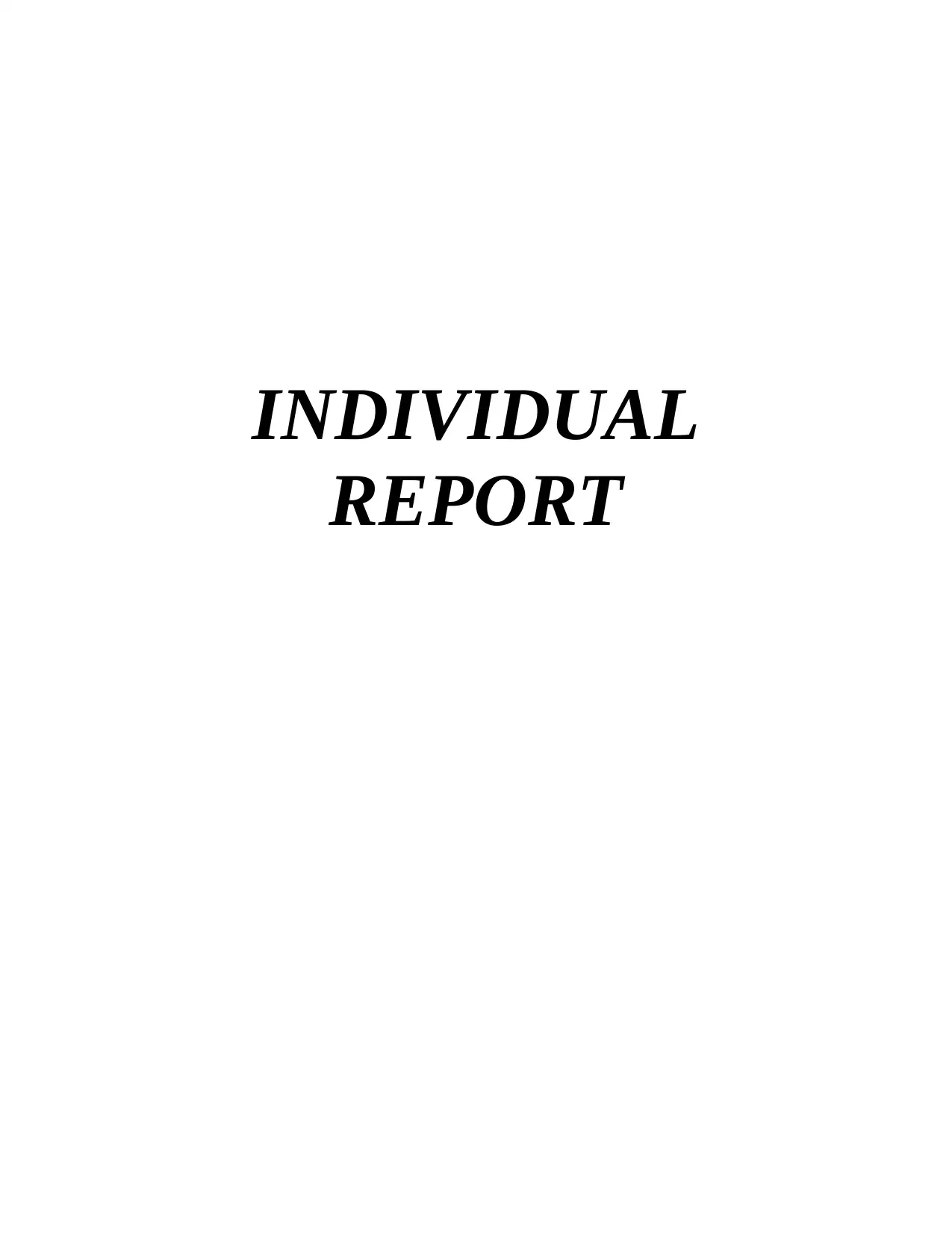
INDIVIDUAL
REPORT
REPORT
Secure Best Marks with AI Grader
Need help grading? Try our AI Grader for instant feedback on your assignments.
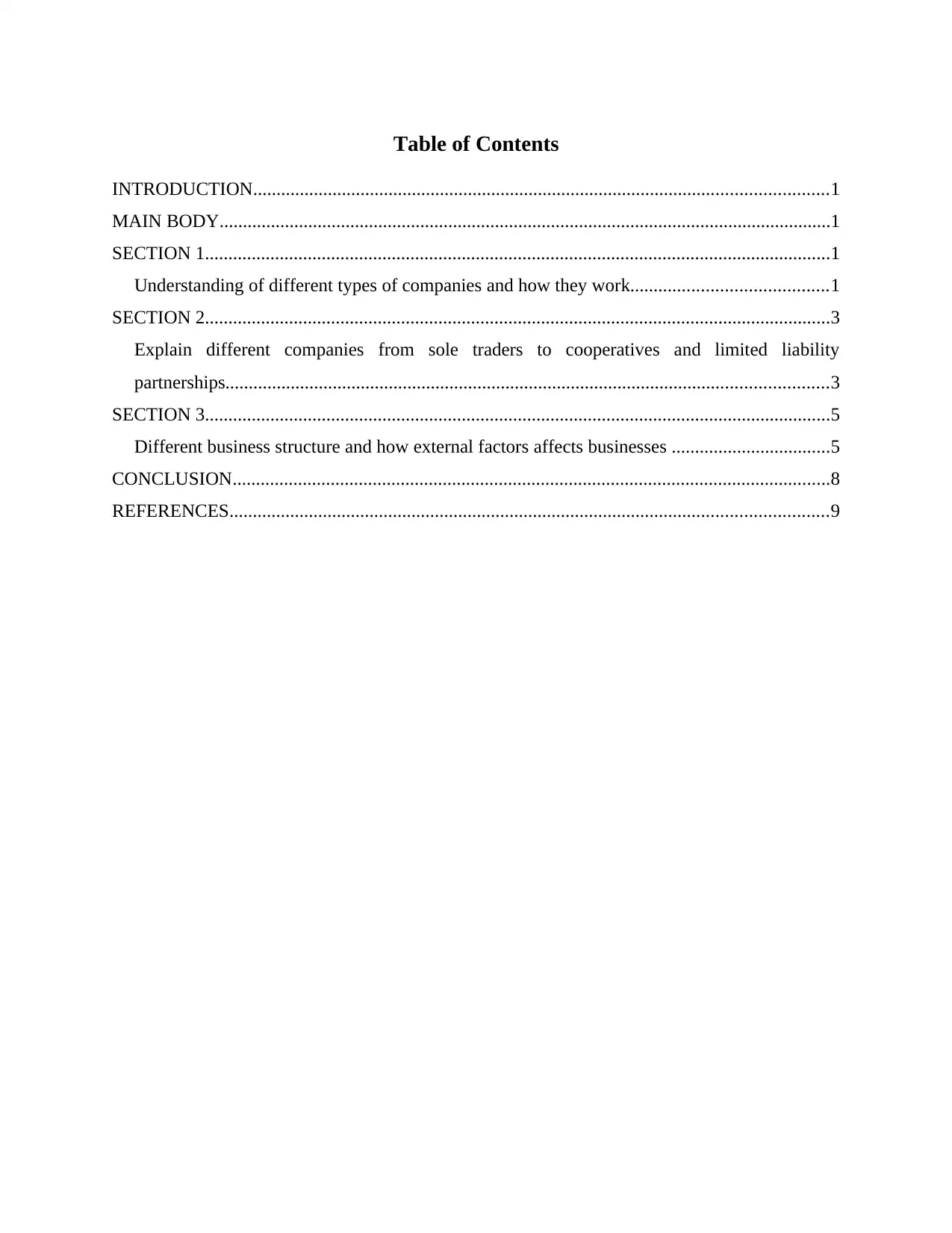
Table of Contents
INTRODUCTION...........................................................................................................................1
MAIN BODY...................................................................................................................................1
SECTION 1......................................................................................................................................1
Understanding of different types of companies and how they work..........................................1
SECTION 2......................................................................................................................................3
Explain different companies from sole traders to cooperatives and limited liability
partnerships.................................................................................................................................3
SECTION 3......................................................................................................................................5
Different business structure and how external factors affects businesses ..................................5
CONCLUSION................................................................................................................................8
REFERENCES................................................................................................................................9
INTRODUCTION...........................................................................................................................1
MAIN BODY...................................................................................................................................1
SECTION 1......................................................................................................................................1
Understanding of different types of companies and how they work..........................................1
SECTION 2......................................................................................................................................3
Explain different companies from sole traders to cooperatives and limited liability
partnerships.................................................................................................................................3
SECTION 3......................................................................................................................................5
Different business structure and how external factors affects businesses ..................................5
CONCLUSION................................................................................................................................8
REFERENCES................................................................................................................................9
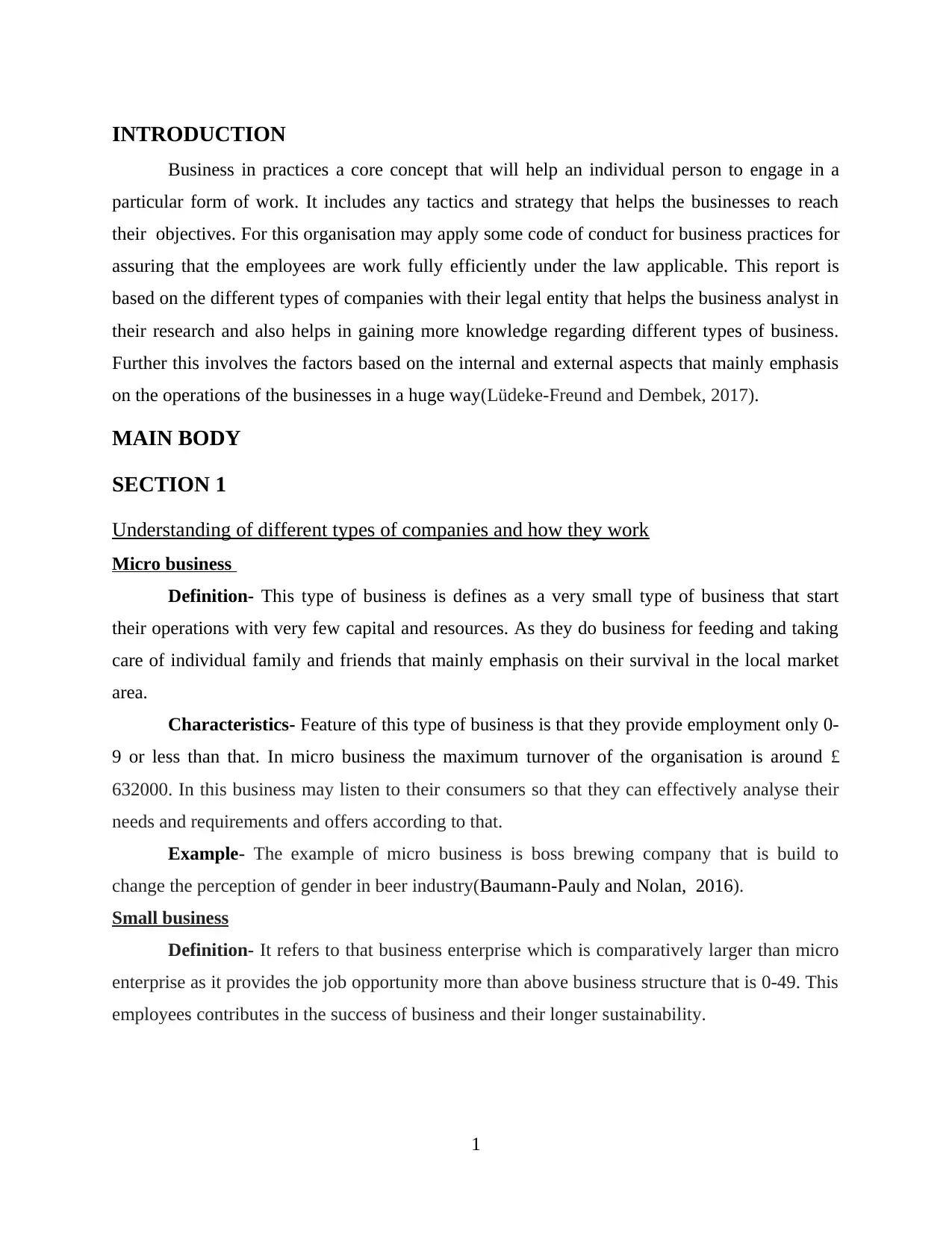
INTRODUCTION
Business in practices a core concept that will help an individual person to engage in a
particular form of work. It includes any tactics and strategy that helps the businesses to reach
their objectives. For this organisation may apply some code of conduct for business practices for
assuring that the employees are work fully efficiently under the law applicable. This report is
based on the different types of companies with their legal entity that helps the business analyst in
their research and also helps in gaining more knowledge regarding different types of business.
Further this involves the factors based on the internal and external aspects that mainly emphasis
on the operations of the businesses in a huge way(Lüdeke-Freund and Dembek, 2017).
MAIN BODY
SECTION 1
Understanding of different types of companies and how they work
Micro business
Definition- This type of business is defines as a very small type of business that start
their operations with very few capital and resources. As they do business for feeding and taking
care of individual family and friends that mainly emphasis on their survival in the local market
area.
Characteristics- Feature of this type of business is that they provide employment only 0-
9 or less than that. In micro business the maximum turnover of the organisation is around £
632000. In this business may listen to their consumers so that they can effectively analyse their
needs and requirements and offers according to that.
Example- The example of micro business is boss brewing company that is build to
change the perception of gender in beer industry(Baumann-Pauly and Nolan, 2016).
Small business
Definition- It refers to that business enterprise which is comparatively larger than micro
enterprise as it provides the job opportunity more than above business structure that is 0-49. This
employees contributes in the success of business and their longer sustainability.
1
Business in practices a core concept that will help an individual person to engage in a
particular form of work. It includes any tactics and strategy that helps the businesses to reach
their objectives. For this organisation may apply some code of conduct for business practices for
assuring that the employees are work fully efficiently under the law applicable. This report is
based on the different types of companies with their legal entity that helps the business analyst in
their research and also helps in gaining more knowledge regarding different types of business.
Further this involves the factors based on the internal and external aspects that mainly emphasis
on the operations of the businesses in a huge way(Lüdeke-Freund and Dembek, 2017).
MAIN BODY
SECTION 1
Understanding of different types of companies and how they work
Micro business
Definition- This type of business is defines as a very small type of business that start
their operations with very few capital and resources. As they do business for feeding and taking
care of individual family and friends that mainly emphasis on their survival in the local market
area.
Characteristics- Feature of this type of business is that they provide employment only 0-
9 or less than that. In micro business the maximum turnover of the organisation is around £
632000. In this business may listen to their consumers so that they can effectively analyse their
needs and requirements and offers according to that.
Example- The example of micro business is boss brewing company that is build to
change the perception of gender in beer industry(Baumann-Pauly and Nolan, 2016).
Small business
Definition- It refers to that business enterprise which is comparatively larger than micro
enterprise as it provides the job opportunity more than above business structure that is 0-49. This
employees contributes in the success of business and their longer sustainability.
1
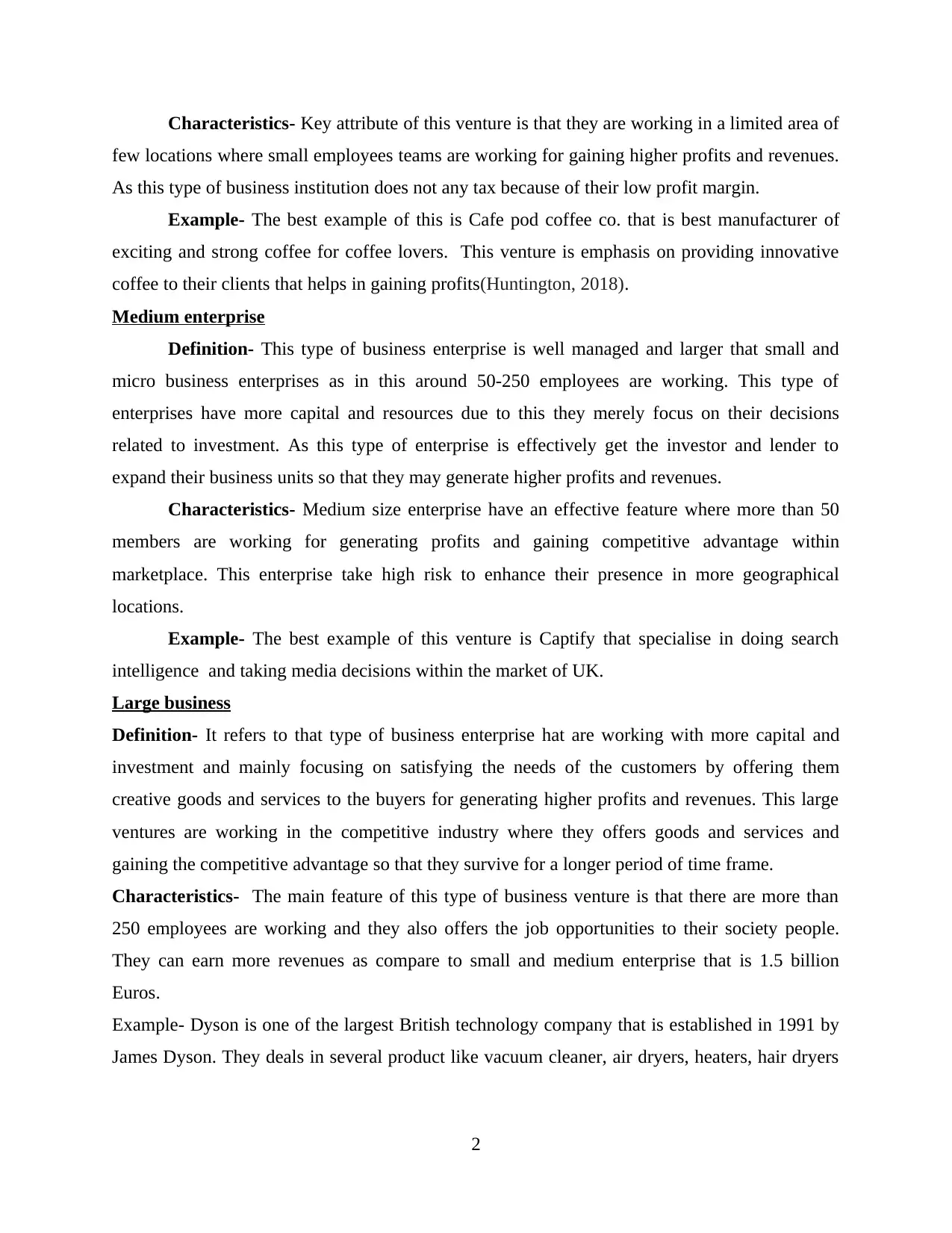
Characteristics- Key attribute of this venture is that they are working in a limited area of
few locations where small employees teams are working for gaining higher profits and revenues.
As this type of business institution does not any tax because of their low profit margin.
Example- The best example of this is Cafe pod coffee co. that is best manufacturer of
exciting and strong coffee for coffee lovers. This venture is emphasis on providing innovative
coffee to their clients that helps in gaining profits(Huntington, 2018).
Medium enterprise
Definition- This type of business enterprise is well managed and larger that small and
micro business enterprises as in this around 50-250 employees are working. This type of
enterprises have more capital and resources due to this they merely focus on their decisions
related to investment. As this type of enterprise is effectively get the investor and lender to
expand their business units so that they may generate higher profits and revenues.
Characteristics- Medium size enterprise have an effective feature where more than 50
members are working for generating profits and gaining competitive advantage within
marketplace. This enterprise take high risk to enhance their presence in more geographical
locations.
Example- The best example of this venture is Captify that specialise in doing search
intelligence and taking media decisions within the market of UK.
Large business
Definition- It refers to that type of business enterprise hat are working with more capital and
investment and mainly focusing on satisfying the needs of the customers by offering them
creative goods and services to the buyers for generating higher profits and revenues. This large
ventures are working in the competitive industry where they offers goods and services and
gaining the competitive advantage so that they survive for a longer period of time frame.
Characteristics- The main feature of this type of business venture is that there are more than
250 employees are working and they also offers the job opportunities to their society people.
They can earn more revenues as compare to small and medium enterprise that is 1.5 billion
Euros.
Example- Dyson is one of the largest British technology company that is established in 1991 by
James Dyson. They deals in several product like vacuum cleaner, air dryers, heaters, hair dryers
2
few locations where small employees teams are working for gaining higher profits and revenues.
As this type of business institution does not any tax because of their low profit margin.
Example- The best example of this is Cafe pod coffee co. that is best manufacturer of
exciting and strong coffee for coffee lovers. This venture is emphasis on providing innovative
coffee to their clients that helps in gaining profits(Huntington, 2018).
Medium enterprise
Definition- This type of business enterprise is well managed and larger that small and
micro business enterprises as in this around 50-250 employees are working. This type of
enterprises have more capital and resources due to this they merely focus on their decisions
related to investment. As this type of enterprise is effectively get the investor and lender to
expand their business units so that they may generate higher profits and revenues.
Characteristics- Medium size enterprise have an effective feature where more than 50
members are working for generating profits and gaining competitive advantage within
marketplace. This enterprise take high risk to enhance their presence in more geographical
locations.
Example- The best example of this venture is Captify that specialise in doing search
intelligence and taking media decisions within the market of UK.
Large business
Definition- It refers to that type of business enterprise hat are working with more capital and
investment and mainly focusing on satisfying the needs of the customers by offering them
creative goods and services to the buyers for generating higher profits and revenues. This large
ventures are working in the competitive industry where they offers goods and services and
gaining the competitive advantage so that they survive for a longer period of time frame.
Characteristics- The main feature of this type of business venture is that there are more than
250 employees are working and they also offers the job opportunities to their society people.
They can earn more revenues as compare to small and medium enterprise that is 1.5 billion
Euros.
Example- Dyson is one of the largest British technology company that is established in 1991 by
James Dyson. They deals in several product like vacuum cleaner, air dryers, heaters, hair dryers
2
Secure Best Marks with AI Grader
Need help grading? Try our AI Grader for instant feedback on your assignments.
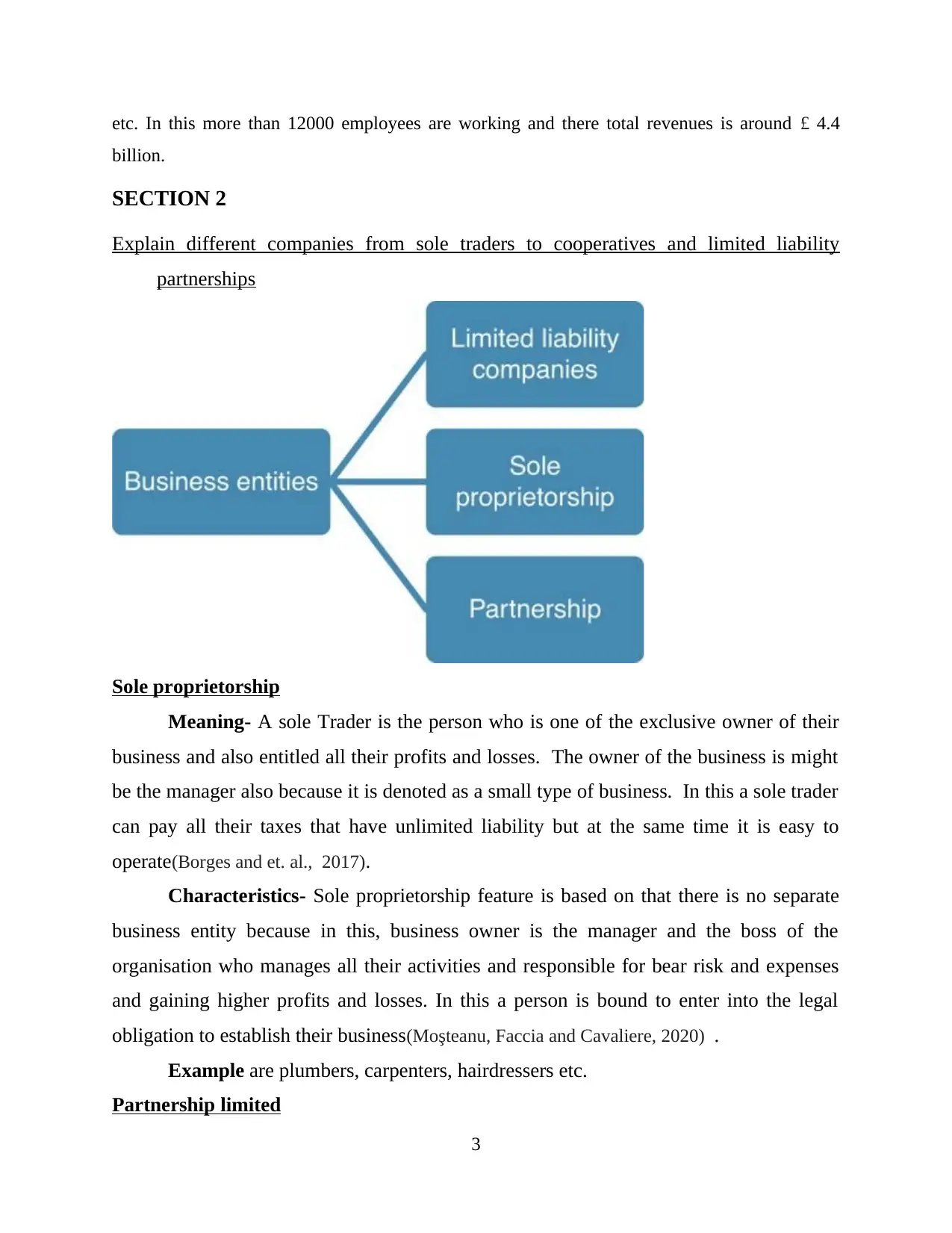
etc. In this more than 12000 employees are working and there total revenues is around £ 4.4
billion.
SECTION 2
Explain different companies from sole traders to cooperatives and limited liability
partnerships
Sole proprietorship
Meaning- A sole Trader is the person who is one of the exclusive owner of their
business and also entitled all their profits and losses. The owner of the business is might
be the manager also because it is denoted as a small type of business. In this a sole trader
can pay all their taxes that have unlimited liability but at the same time it is easy to
operate(Borges and et. al., 2017).
Characteristics- Sole proprietorship feature is based on that there is no separate
business entity because in this, business owner is the manager and the boss of the
organisation who manages all their activities and responsible for bear risk and expenses
and gaining higher profits and losses. In this a person is bound to enter into the legal
obligation to establish their business(Moşteanu, Faccia and Cavaliere, 2020) .
Example are plumbers, carpenters, hairdressers etc.
Partnership limited
3
billion.
SECTION 2
Explain different companies from sole traders to cooperatives and limited liability
partnerships
Sole proprietorship
Meaning- A sole Trader is the person who is one of the exclusive owner of their
business and also entitled all their profits and losses. The owner of the business is might
be the manager also because it is denoted as a small type of business. In this a sole trader
can pay all their taxes that have unlimited liability but at the same time it is easy to
operate(Borges and et. al., 2017).
Characteristics- Sole proprietorship feature is based on that there is no separate
business entity because in this, business owner is the manager and the boss of the
organisation who manages all their activities and responsible for bear risk and expenses
and gaining higher profits and losses. In this a person is bound to enter into the legal
obligation to establish their business(Moşteanu, Faccia and Cavaliere, 2020) .
Example are plumbers, carpenters, hairdressers etc.
Partnership limited
3
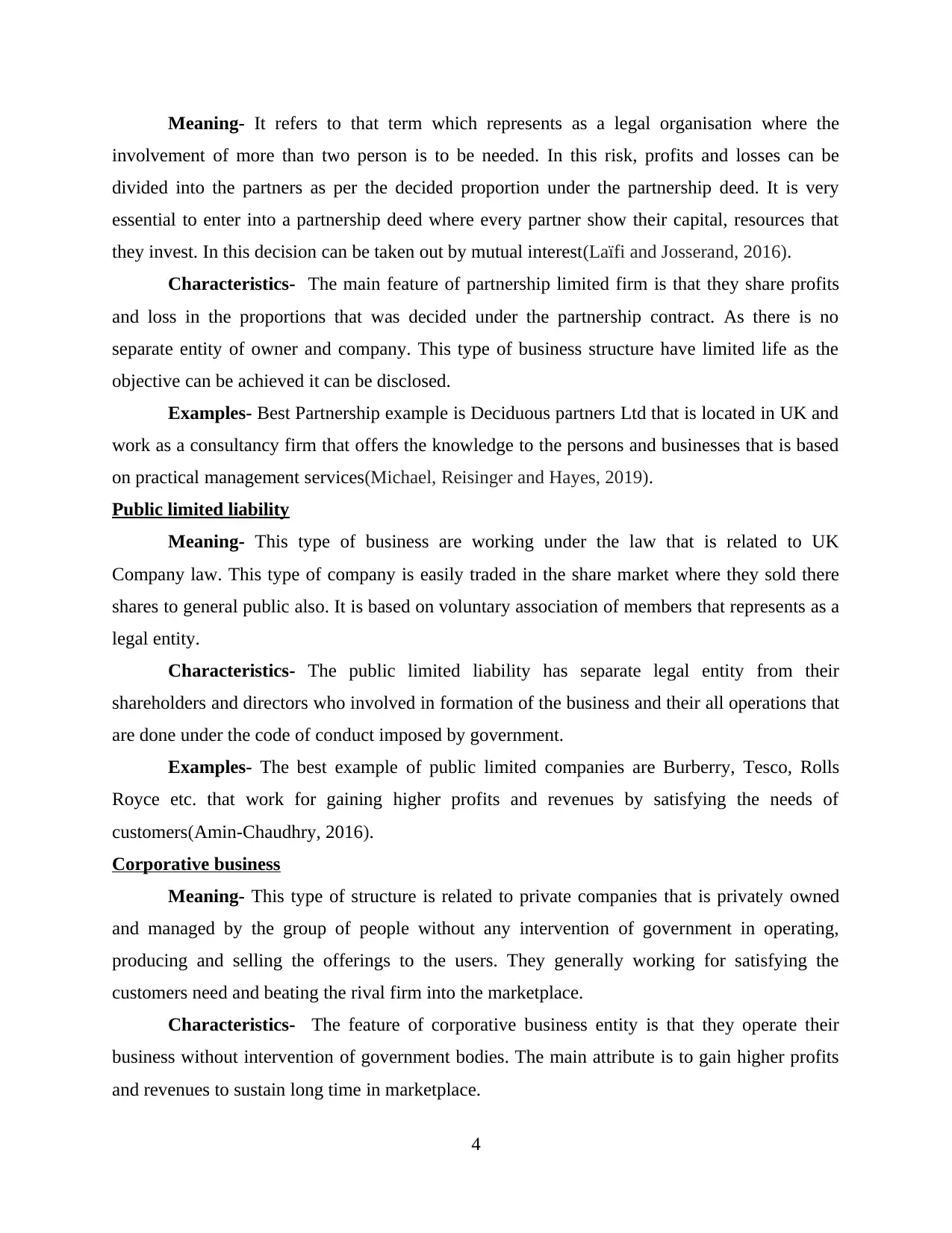
Meaning- It refers to that term which represents as a legal organisation where the
involvement of more than two person is to be needed. In this risk, profits and losses can be
divided into the partners as per the decided proportion under the partnership deed. It is very
essential to enter into a partnership deed where every partner show their capital, resources that
they invest. In this decision can be taken out by mutual interest(Laïfi and Josserand, 2016).
Characteristics- The main feature of partnership limited firm is that they share profits
and loss in the proportions that was decided under the partnership contract. As there is no
separate entity of owner and company. This type of business structure have limited life as the
objective can be achieved it can be disclosed.
Examples- Best Partnership example is Deciduous partners Ltd that is located in UK and
work as a consultancy firm that offers the knowledge to the persons and businesses that is based
on practical management services(Michael, Reisinger and Hayes, 2019).
Public limited liability
Meaning- This type of business are working under the law that is related to UK
Company law. This type of company is easily traded in the share market where they sold there
shares to general public also. It is based on voluntary association of members that represents as a
legal entity.
Characteristics- The public limited liability has separate legal entity from their
shareholders and directors who involved in formation of the business and their all operations that
are done under the code of conduct imposed by government.
Examples- The best example of public limited companies are Burberry, Tesco, Rolls
Royce etc. that work for gaining higher profits and revenues by satisfying the needs of
customers(Amin-Chaudhry, 2016).
Corporative business
Meaning- This type of structure is related to private companies that is privately owned
and managed by the group of people without any intervention of government in operating,
producing and selling the offerings to the users. They generally working for satisfying the
customers need and beating the rival firm into the marketplace.
Characteristics- The feature of corporative business entity is that they operate their
business without intervention of government bodies. The main attribute is to gain higher profits
and revenues to sustain long time in marketplace.
4
involvement of more than two person is to be needed. In this risk, profits and losses can be
divided into the partners as per the decided proportion under the partnership deed. It is very
essential to enter into a partnership deed where every partner show their capital, resources that
they invest. In this decision can be taken out by mutual interest(Laïfi and Josserand, 2016).
Characteristics- The main feature of partnership limited firm is that they share profits
and loss in the proportions that was decided under the partnership contract. As there is no
separate entity of owner and company. This type of business structure have limited life as the
objective can be achieved it can be disclosed.
Examples- Best Partnership example is Deciduous partners Ltd that is located in UK and
work as a consultancy firm that offers the knowledge to the persons and businesses that is based
on practical management services(Michael, Reisinger and Hayes, 2019).
Public limited liability
Meaning- This type of business are working under the law that is related to UK
Company law. This type of company is easily traded in the share market where they sold there
shares to general public also. It is based on voluntary association of members that represents as a
legal entity.
Characteristics- The public limited liability has separate legal entity from their
shareholders and directors who involved in formation of the business and their all operations that
are done under the code of conduct imposed by government.
Examples- The best example of public limited companies are Burberry, Tesco, Rolls
Royce etc. that work for gaining higher profits and revenues by satisfying the needs of
customers(Amin-Chaudhry, 2016).
Corporative business
Meaning- This type of structure is related to private companies that is privately owned
and managed by the group of people without any intervention of government in operating,
producing and selling the offerings to the users. They generally working for satisfying the
customers need and beating the rival firm into the marketplace.
Characteristics- The feature of corporative business entity is that they operate their
business without intervention of government bodies. The main attribute is to gain higher profits
and revenues to sustain long time in marketplace.
4
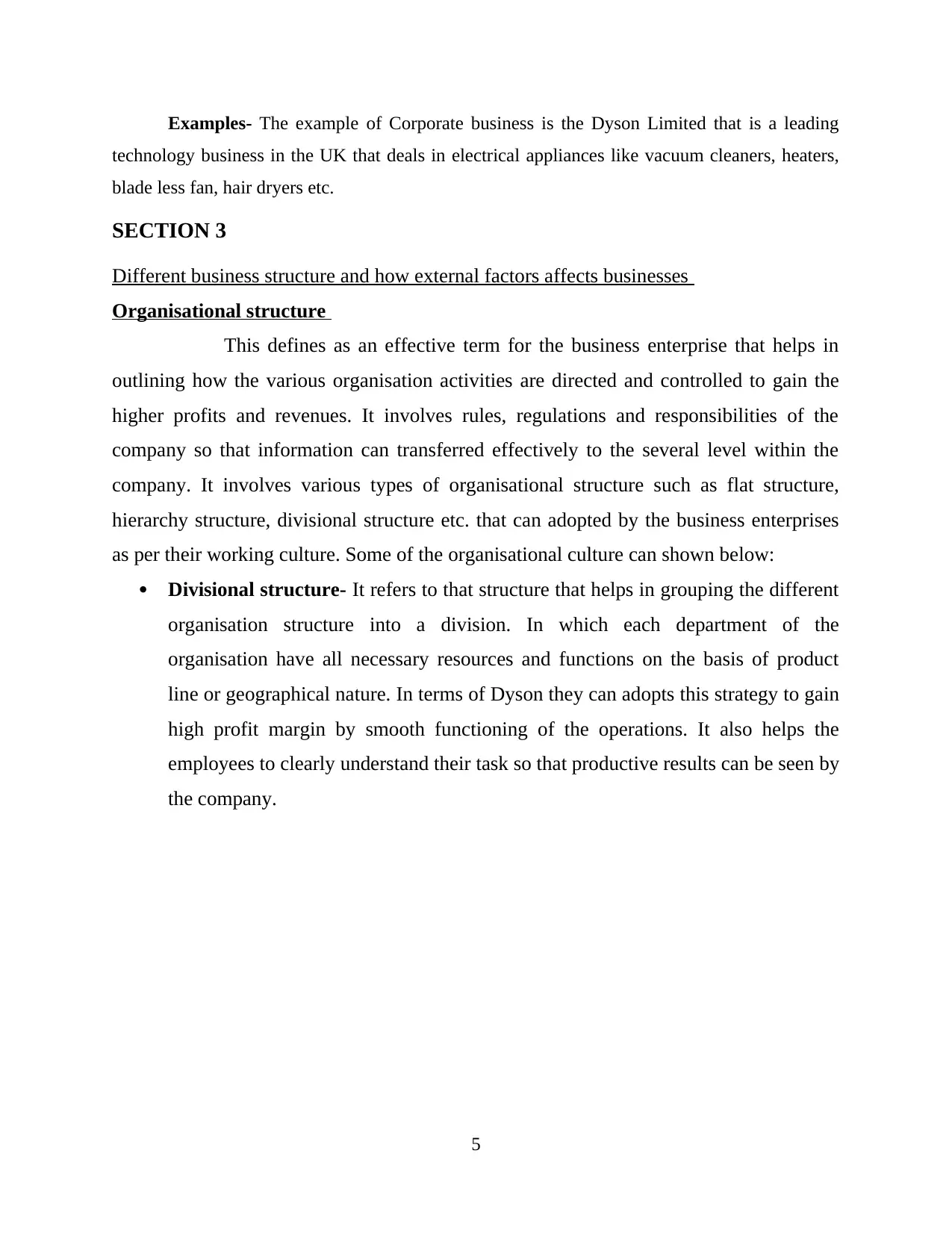
Examples- The example of Corporate business is the Dyson Limited that is a leading
technology business in the UK that deals in electrical appliances like vacuum cleaners, heaters,
blade less fan, hair dryers etc.
SECTION 3
Different business structure and how external factors affects businesses
Organisational structure
This defines as an effective term for the business enterprise that helps in
outlining how the various organisation activities are directed and controlled to gain the
higher profits and revenues. It involves rules, regulations and responsibilities of the
company so that information can transferred effectively to the several level within the
company. It involves various types of organisational structure such as flat structure,
hierarchy structure, divisional structure etc. that can adopted by the business enterprises
as per their working culture. Some of the organisational culture can shown below:
Divisional structure- It refers to that structure that helps in grouping the different
organisation structure into a division. In which each department of the
organisation have all necessary resources and functions on the basis of product
line or geographical nature. In terms of Dyson they can adopts this strategy to gain
high profit margin by smooth functioning of the operations. It also helps the
employees to clearly understand their task so that productive results can be seen by
the company.
5
technology business in the UK that deals in electrical appliances like vacuum cleaners, heaters,
blade less fan, hair dryers etc.
SECTION 3
Different business structure and how external factors affects businesses
Organisational structure
This defines as an effective term for the business enterprise that helps in
outlining how the various organisation activities are directed and controlled to gain the
higher profits and revenues. It involves rules, regulations and responsibilities of the
company so that information can transferred effectively to the several level within the
company. It involves various types of organisational structure such as flat structure,
hierarchy structure, divisional structure etc. that can adopted by the business enterprises
as per their working culture. Some of the organisational culture can shown below:
Divisional structure- It refers to that structure that helps in grouping the different
organisation structure into a division. In which each department of the
organisation have all necessary resources and functions on the basis of product
line or geographical nature. In terms of Dyson they can adopts this strategy to gain
high profit margin by smooth functioning of the operations. It also helps the
employees to clearly understand their task so that productive results can be seen by
the company.
5
Paraphrase This Document
Need a fresh take? Get an instant paraphrase of this document with our AI Paraphraser
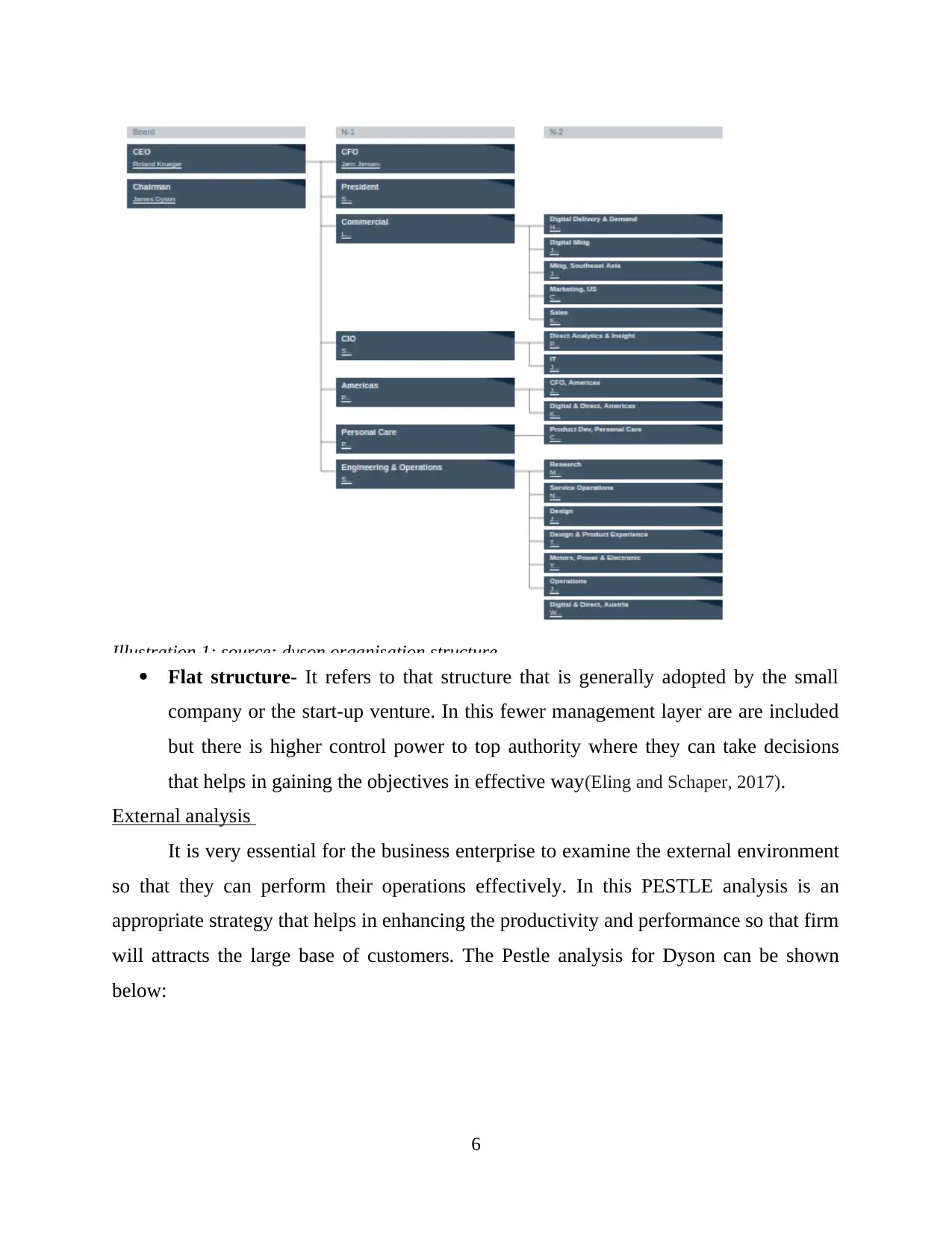
Illustration 1: source: dyson organisation structure
Flat structure- It refers to that structure that is generally adopted by the small
company or the start-up venture. In this fewer management layer are are included
but there is higher control power to top authority where they can take decisions
that helps in gaining the objectives in effective way(Eling and Schaper, 2017).
External analysis
It is very essential for the business enterprise to examine the external environment
so that they can perform their operations effectively. In this PESTLE analysis is an
appropriate strategy that helps in enhancing the productivity and performance so that firm
will attracts the large base of customers. The Pestle analysis for Dyson can be shown
below:
6
Flat structure- It refers to that structure that is generally adopted by the small
company or the start-up venture. In this fewer management layer are are included
but there is higher control power to top authority where they can take decisions
that helps in gaining the objectives in effective way(Eling and Schaper, 2017).
External analysis
It is very essential for the business enterprise to examine the external environment
so that they can perform their operations effectively. In this PESTLE analysis is an
appropriate strategy that helps in enhancing the productivity and performance so that firm
will attracts the large base of customers. The Pestle analysis for Dyson can be shown
below:
6
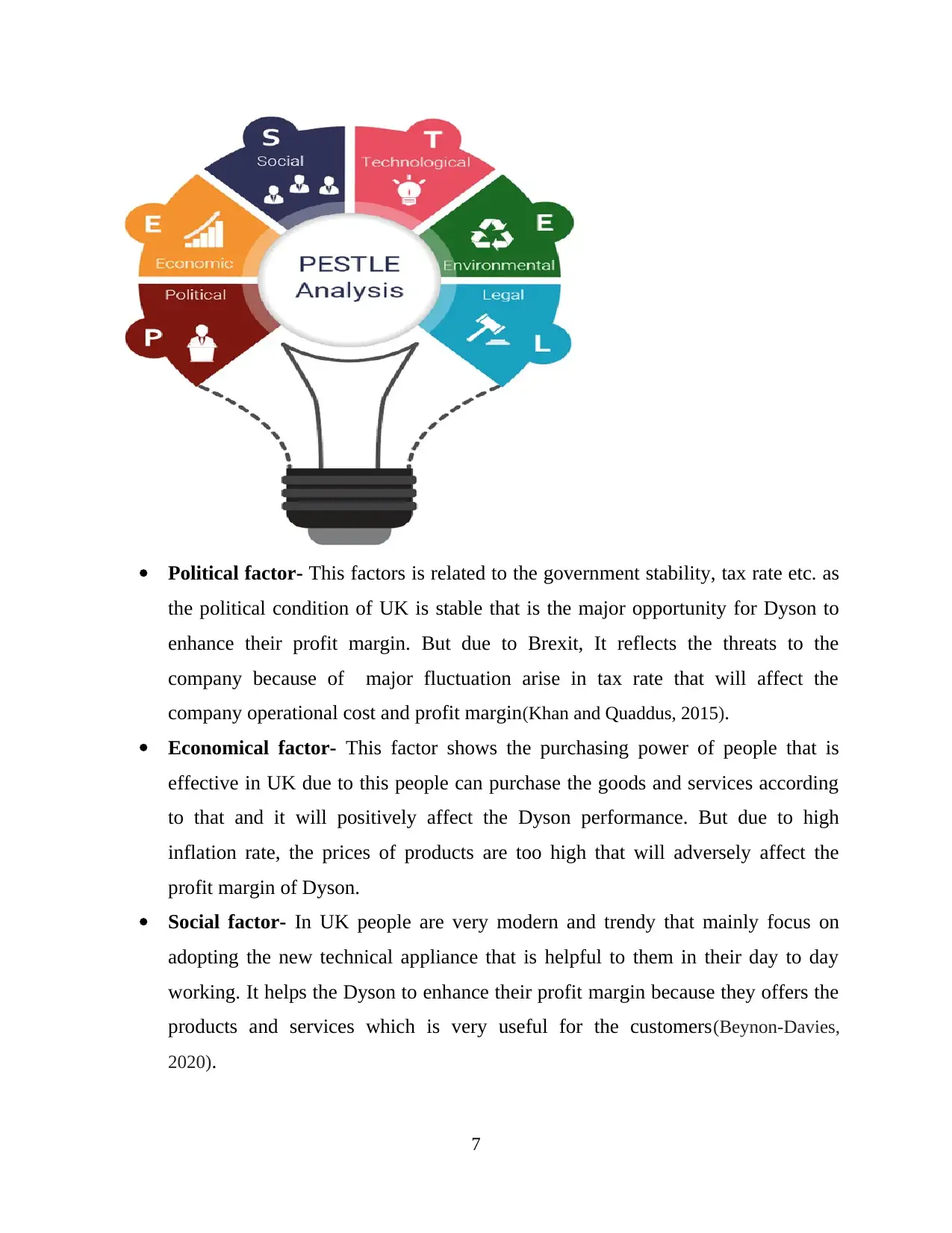
Political factor- This factors is related to the government stability, tax rate etc. as
the political condition of UK is stable that is the major opportunity for Dyson to
enhance their profit margin. But due to Brexit, It reflects the threats to the
company because of major fluctuation arise in tax rate that will affect the
company operational cost and profit margin(Khan and Quaddus, 2015).
Economical factor- This factor shows the purchasing power of people that is
effective in UK due to this people can purchase the goods and services according
to that and it will positively affect the Dyson performance. But due to high
inflation rate, the prices of products are too high that will adversely affect the
profit margin of Dyson.
Social factor- In UK people are very modern and trendy that mainly focus on
adopting the new technical appliance that is helpful to them in their day to day
working. It helps the Dyson to enhance their profit margin because they offers the
products and services which is very useful for the customers(Beynon-Davies,
2020).
7
the political condition of UK is stable that is the major opportunity for Dyson to
enhance their profit margin. But due to Brexit, It reflects the threats to the
company because of major fluctuation arise in tax rate that will affect the
company operational cost and profit margin(Khan and Quaddus, 2015).
Economical factor- This factor shows the purchasing power of people that is
effective in UK due to this people can purchase the goods and services according
to that and it will positively affect the Dyson performance. But due to high
inflation rate, the prices of products are too high that will adversely affect the
profit margin of Dyson.
Social factor- In UK people are very modern and trendy that mainly focus on
adopting the new technical appliance that is helpful to them in their day to day
working. It helps the Dyson to enhance their profit margin because they offers the
products and services which is very useful for the customers(Beynon-Davies,
2020).
7
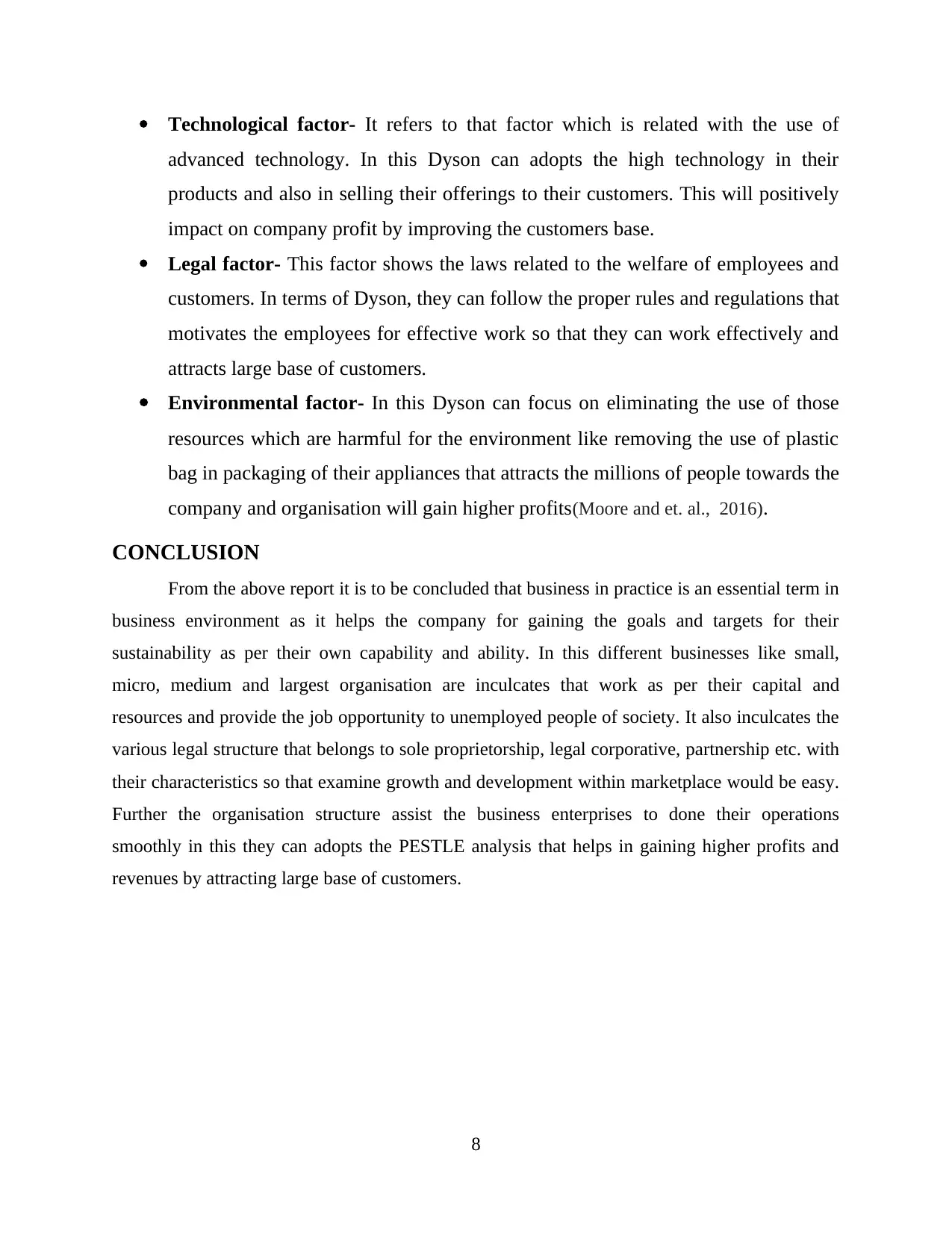
Technological factor- It refers to that factor which is related with the use of
advanced technology. In this Dyson can adopts the high technology in their
products and also in selling their offerings to their customers. This will positively
impact on company profit by improving the customers base.
Legal factor- This factor shows the laws related to the welfare of employees and
customers. In terms of Dyson, they can follow the proper rules and regulations that
motivates the employees for effective work so that they can work effectively and
attracts large base of customers.
Environmental factor- In this Dyson can focus on eliminating the use of those
resources which are harmful for the environment like removing the use of plastic
bag in packaging of their appliances that attracts the millions of people towards the
company and organisation will gain higher profits(Moore and et. al., 2016).
CONCLUSION
From the above report it is to be concluded that business in practice is an essential term in
business environment as it helps the company for gaining the goals and targets for their
sustainability as per their own capability and ability. In this different businesses like small,
micro, medium and largest organisation are inculcates that work as per their capital and
resources and provide the job opportunity to unemployed people of society. It also inculcates the
various legal structure that belongs to sole proprietorship, legal corporative, partnership etc. with
their characteristics so that examine growth and development within marketplace would be easy.
Further the organisation structure assist the business enterprises to done their operations
smoothly in this they can adopts the PESTLE analysis that helps in gaining higher profits and
revenues by attracting large base of customers.
8
advanced technology. In this Dyson can adopts the high technology in their
products and also in selling their offerings to their customers. This will positively
impact on company profit by improving the customers base.
Legal factor- This factor shows the laws related to the welfare of employees and
customers. In terms of Dyson, they can follow the proper rules and regulations that
motivates the employees for effective work so that they can work effectively and
attracts large base of customers.
Environmental factor- In this Dyson can focus on eliminating the use of those
resources which are harmful for the environment like removing the use of plastic
bag in packaging of their appliances that attracts the millions of people towards the
company and organisation will gain higher profits(Moore and et. al., 2016).
CONCLUSION
From the above report it is to be concluded that business in practice is an essential term in
business environment as it helps the company for gaining the goals and targets for their
sustainability as per their own capability and ability. In this different businesses like small,
micro, medium and largest organisation are inculcates that work as per their capital and
resources and provide the job opportunity to unemployed people of society. It also inculcates the
various legal structure that belongs to sole proprietorship, legal corporative, partnership etc. with
their characteristics so that examine growth and development within marketplace would be easy.
Further the organisation structure assist the business enterprises to done their operations
smoothly in this they can adopts the PESTLE analysis that helps in gaining higher profits and
revenues by attracting large base of customers.
8
Secure Best Marks with AI Grader
Need help grading? Try our AI Grader for instant feedback on your assignments.
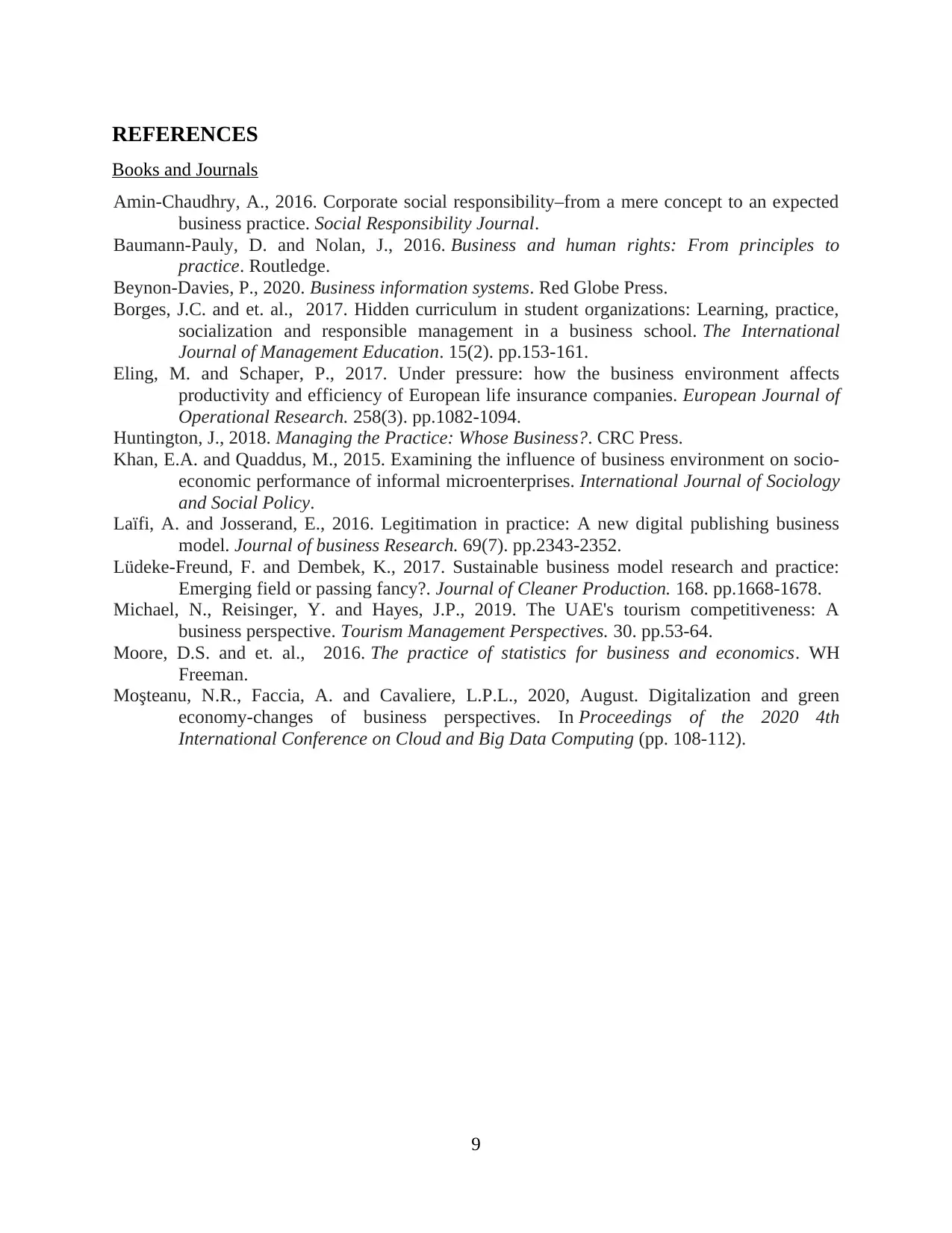
REFERENCES
Books and Journals
Amin-Chaudhry, A., 2016. Corporate social responsibility–from a mere concept to an expected
business practice. Social Responsibility Journal.
Baumann-Pauly, D. and Nolan, J., 2016. Business and human rights: From principles to
practice. Routledge.
Beynon-Davies, P., 2020. Business information systems. Red Globe Press.
Borges, J.C. and et. al., 2017. Hidden curriculum in student organizations: Learning, practice,
socialization and responsible management in a business school. The International
Journal of Management Education. 15(2). pp.153-161.
Eling, M. and Schaper, P., 2017. Under pressure: how the business environment affects
productivity and efficiency of European life insurance companies. European Journal of
Operational Research. 258(3). pp.1082-1094.
Huntington, J., 2018. Managing the Practice: Whose Business?. CRC Press.
Khan, E.A. and Quaddus, M., 2015. Examining the influence of business environment on socio-
economic performance of informal microenterprises. International Journal of Sociology
and Social Policy.
Laïfi, A. and Josserand, E., 2016. Legitimation in practice: A new digital publishing business
model. Journal of business Research. 69(7). pp.2343-2352.
Lüdeke-Freund, F. and Dembek, K., 2017. Sustainable business model research and practice:
Emerging field or passing fancy?. Journal of Cleaner Production. 168. pp.1668-1678.
Michael, N., Reisinger, Y. and Hayes, J.P., 2019. The UAE's tourism competitiveness: A
business perspective. Tourism Management Perspectives. 30. pp.53-64.
Moore, D.S. and et. al., 2016. The practice of statistics for business and economics. WH
Freeman.
Moşteanu, N.R., Faccia, A. and Cavaliere, L.P.L., 2020, August. Digitalization and green
economy-changes of business perspectives. In Proceedings of the 2020 4th
International Conference on Cloud and Big Data Computing (pp. 108-112).
9
Books and Journals
Amin-Chaudhry, A., 2016. Corporate social responsibility–from a mere concept to an expected
business practice. Social Responsibility Journal.
Baumann-Pauly, D. and Nolan, J., 2016. Business and human rights: From principles to
practice. Routledge.
Beynon-Davies, P., 2020. Business information systems. Red Globe Press.
Borges, J.C. and et. al., 2017. Hidden curriculum in student organizations: Learning, practice,
socialization and responsible management in a business school. The International
Journal of Management Education. 15(2). pp.153-161.
Eling, M. and Schaper, P., 2017. Under pressure: how the business environment affects
productivity and efficiency of European life insurance companies. European Journal of
Operational Research. 258(3). pp.1082-1094.
Huntington, J., 2018. Managing the Practice: Whose Business?. CRC Press.
Khan, E.A. and Quaddus, M., 2015. Examining the influence of business environment on socio-
economic performance of informal microenterprises. International Journal of Sociology
and Social Policy.
Laïfi, A. and Josserand, E., 2016. Legitimation in practice: A new digital publishing business
model. Journal of business Research. 69(7). pp.2343-2352.
Lüdeke-Freund, F. and Dembek, K., 2017. Sustainable business model research and practice:
Emerging field or passing fancy?. Journal of Cleaner Production. 168. pp.1668-1678.
Michael, N., Reisinger, Y. and Hayes, J.P., 2019. The UAE's tourism competitiveness: A
business perspective. Tourism Management Perspectives. 30. pp.53-64.
Moore, D.S. and et. al., 2016. The practice of statistics for business and economics. WH
Freeman.
Moşteanu, N.R., Faccia, A. and Cavaliere, L.P.L., 2020, August. Digitalization and green
economy-changes of business perspectives. In Proceedings of the 2020 4th
International Conference on Cloud and Big Data Computing (pp. 108-112).
9
1 out of 11
Related Documents
Your All-in-One AI-Powered Toolkit for Academic Success.
+13062052269
info@desklib.com
Available 24*7 on WhatsApp / Email
![[object Object]](/_next/static/media/star-bottom.7253800d.svg)
Unlock your academic potential
© 2024 | Zucol Services PVT LTD | All rights reserved.




